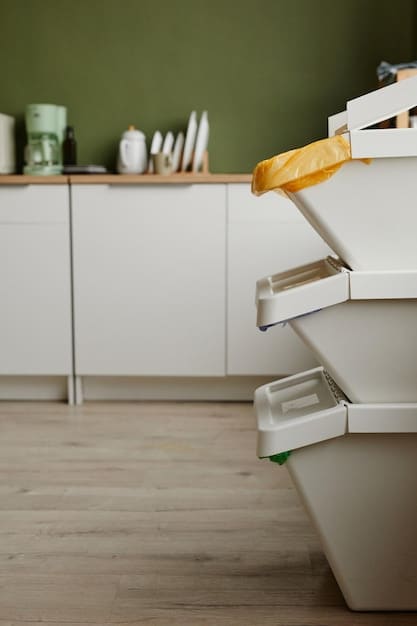Green Your Home Office: Sustainable Practices for a Productive Workspace

Green your home office by incorporating sustainable practices such as using energy-efficient equipment, opting for eco-friendly furniture and supplies, maximizing natural light, and adopting mindful consumption habits to create a productive and environmentally responsible workspace.
Transforming your workspace into a haven of productivity and sustainability is more achievable than you might think; discover how simple changes can redefine your work environment by allowing you to green your home office: sustainable practices for a productive workspace and bring about a harmonious blend of ecological responsibility and work efficiency.
Creating an Eco-Friendly Foundation
When embarking on the journey to green your home office, the first step involves establishing an eco-friendly foundation by making conscious selections in furniture and supplies. Let’s explore how thoughtful choices can lead to a sustainable workspace.
Choosing Sustainable Furniture
The materials from which your furniture is made can significantly impact your environmental footprint. Look for items made from recycled materials, bamboo, or sustainably harvested wood.
Eco-Friendly Office Supplies
Replace conventional office supplies with eco-friendly alternatives. Opt for recycled paper, refillable pens, and biodegradable packaging. These small changes can add up to make a big difference.
- Recycled Paper: Using recycled paper reduces the demand for virgin wood pulp, conserving forests.
- Refillable Pens: Refillable pens minimize plastic waste compared to disposable pens.
- Biodegradable Packaging: Biodegradable packaging reduces the environmental impact of disposal.
- Reusable Containers: Utilize reusable containers for storage and organization.
By conscientiously choosing furniture and supplies, you set a strong foundation for a truly green home office. This commitment not only benefits the planet but also promotes a healthier and more inspiring work environment.

Energy-Efficient Equipment and Lighting
A vital aspect of greening your home office is optimizing your energy usage through efficient equipment and lighting. Let’s dive into the ways you can minimize energy consumption without compromising productivity.
Energy-Star Appliances
When selecting equipment such as computers, printers, and monitors, look for the Energy Star label. These appliances are designed to use less energy, reducing your electricity bill and environmental impact.
Optimizing Natural Light and LED Lighting
Maximize the use of natural light by positioning your desk near a window. When natural light isn’t sufficient, use LED lighting, which consumes significantly less energy than traditional incandescent bulbs.
- Natural Light: Boosts mood and productivity while reducing reliance on artificial lighting.
- LED Lighting: Offers long-lasting and energy-efficient illumination.
- Smart Lighting Systems: Provides automated controls to optimize energy consumption.
By adopting energy-efficient equipment and optimizing your lighting, you’ll not only reduce your carbon footprint but also create a more comfortable and productive workspace. These changes contribute to a more sustainable lifestyle and a healthier planet.
Indoor Plants and Air Quality
Improving the air quality in your home office is essential for your health and productivity. Indoor plants not only enhance the aesthetics of your workspace but also purify the air, creating a healthier environment.
Benefits of Indoor Plants
Plants absorb carbon dioxide and release oxygen, improving air quality. Some plants also filter out common household toxins, such as formaldehyde and benzene.
Best Plants for Air Purification
Consider adding plants like snake plants, spider plants, peace lilies, and pothos to your home office. These plants are known for their air-purifying properties and are relatively easy to care for.
- Snake Plant: Converts CO2 to oxygen at night, making it ideal for bedrooms and offices.
- Spider Plant: Removes formaldehyde, xylene, and carbon monoxide from the air.
- Peace Lily: Filters mold spores and other allergens, promoting cleaner air.
- Pothos: One of the easiest plants to grow, effectively removing indoor pollutants.
Incorporating indoor plants into your home office is a simple yet effective way to improve air quality and create a more pleasant and productive work environment. The natural greenery can also reduce stress and boost your overall well-being.
Managing Waste and Recycling
Effective waste management and recycling practices are crucial to minimize the environmental impact of your home office. Let’s explore how you can reduce waste and promote recycling in your workspace.
Setting Up a Recycling System
Establish a comprehensive recycling system with separate bins for paper, plastics, and other recyclable materials. Make it easy to sort and dispose of waste properly.
Reducing Paper Usage
Minimize paper usage by using digital documents, taking notes on a tablet, and printing only when necessary. When printing is required, use both sides of the paper.
- Digital Documents: Store and share documents electronically to reduce paper consumption.
- Double-Sided Printing: Saves paper by utilizing both sides of each sheet.
- Reusable Mugs and Bottles: Reduces waste from disposable drink containers.
By implementing effective waste management and recycling practices, you can significantly reduce the environmental footprint of your home office, contributing to a cleaner and more sustainable environment.

Sustainable Tech Habits
Adopting sustainable tech habits can significantly reduce your environmental impact while working from home. Small changes in your digital routines can lead to big environmental benefits.
Power Management Settings
Adjust your computer’s power management settings to automatically enter sleep mode when inactive. This reduces energy consumption and extends the lifespan of your devices.
Responsible E-Waste Disposal
Properly dispose of electronic waste by recycling old computers, phones, and other devices at certified recycling centers. This prevents harmful materials from ending up in landfills.
- Sleep Mode: Reduces energy consumption during periods of inactivity.
- Certified Recycling Centers: Ensures proper handling and recycling of electronic waste.
- Unplug Chargers: Reduces phantom energy drain by unplugging chargers when not in use.
By adopting sustainable tech habits, you can minimize your digital carbon footprint and contribute to a more environmentally responsible lifestyle. These practices are not only good for the planet but can also lead to cost savings over time.
Creating a Mindful Consumption Mindset
Adopting a mindful consumption mindset is critical in greening your home office. Being conscious of your consumption habits ensures long-term sustainability and reduces environmental impact.
Buying Less and Buying Smart
Before making a purchase, ask yourself if you really need the item. Opt for durable, high-quality products that will last longer and reduce the need for frequent replacements.
Supporting Eco-Friendly Brands
Support brands that prioritize sustainability and ethical practices. Look for certifications such as Fair Trade, B Corp, and eco-labels when making purchasing decisions.
- Durable Products: Investing in durable items reduces the need for frequent replacements.
- Ethical Brands: Supporting companies committed to sustainability promotes responsible business practices.
- Reusable Packaging: Choosing products with minimal and reusable packaging reduces waste.
By cultivating a mindful consumption mindset, you can make informed decisions that support sustainability and reduce your environmental footprint. These conscious choices contribute to a more responsible and eco-friendly lifestyle.
| Key Area | Brief Description |
|---|---|
| 💡 Energy Efficiency | Use LED lighting and Energy Star appliances to reduce energy consumption. |
| 🌿 Indoor Plants | Incorporate plants like snake plants to improve air quality and reduce stress. |
| ♻️ Waste Reduction | Set up recycling bins and minimize paper use with digital documents. |
| 🌱 Eco-Friendly Supplies | Opt for recycled paper, refillable pens, and sustainable furniture options. |
FAQ
▼
Consider using recycled paper, refillable pens, bamboo-based products, and biodegradable packaging. These reduce waste and promote sustainability in your office.
▼
Use Energy Star-certified appliances, maximize natural light, and switch to LED lighting. Unplug devices when not in use to cut down on phantom energy drain.
▼
Snake plants, spider plants, peace lilies, and pothos are excellent choices. They help remove toxins and purify the air, creating a healthier workspace.
▼
Recycle old electronics at certified recycling centers to prevent harmful materials from ending up in landfills. Check local regulations for e-waste disposal guidelines.
▼
Mindful consumption promotes sustainability by reducing unnecessary purchases and supporting ethical brands. It also leads to more conscious and responsible buying habits.
Conclusion
By integrating these sustainable practices into your home office, you not only contribute to a healthier planet but also create a more productive and inspiring workspace. Embracing eco-friendly habits is a win-win for both your well-being and the environment.





